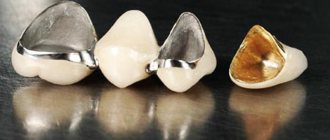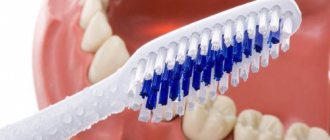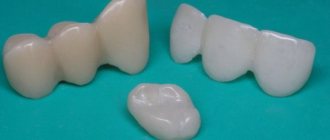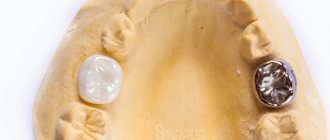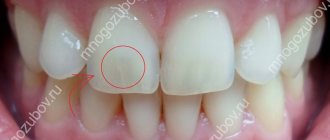From this article you will learn:
- what kind of metal crowns are there for teeth?
- cast crowns - their pros and cons,
- price for 2022.
A one-piece crown is a variant of dental crowns that are made entirely of metal (cobalt-chromium alloy) using one-piece casting technology. This technology assumes that the entire structure is cast at once as a whole, which in the manufacture of solid-cast bridges completely eliminates the need to solder crowns to each other.
A standard solid metal crown does not have any aesthetics, and therefore this prosthetic option is more often used in the lateral sections of the dentition - where such crowns do not fall into the smile line. Despite the lack of aesthetics, cast crowns have a number of advantages. For example, they require less grinding of the tissues of the supporting teeth (compared to metal-ceramics), and also have a significantly lower cost.
Solid metal crown: photo
Cast crowns are made from a cobalt-chromium alloy, which contains about 64% cobalt and up to 30% chromium. There are a lot of options for cobalt-chromium alloys, and they differ from each other in the composition of their minor components. The latter can be molybdenum, tungsten, manganese, silicon, nickel, etc. It is important what kind of alloy the dental clinic (its dental laboratory) will use to make your cast crowns.
Cheap alloys may contain potentially hazardous elements (such as nickel and beryllium), which can cause local allergic reactions and lead to inflammation of the gums around the crown. But these are not all the dangers you may encounter when making solid crowns. And therefore, below we will talk in more detail about their consumer qualities.
What are solid crowns, their advantages and disadvantages
A solid crown is an orthodontic structure used to replace a missing tooth. It is manufactured using the one-piece casting method. Suitable only for restoring chewing teeth; it will not look aesthetically pleasing on the front teeth. The construction is very durable and there are no cracks on it. The minimum service life is 10 years; with proper care, it can be significantly increased.
Advantages:
- affordable price;
- Full compliance with the shape of the tooth, tight fit to the gums;
- manufacturing taking into account the individual structural characteristics of patients’ teeth;
- durability;
- abrasion resistance;
- inertness towards body tissues, lack of negative impact on them;
- during installation, you can do without deep preparation, the teeth are ground down only 0.8 mm;
Flaws:
- unaesthetic appearance;
- high thermal conductivity, which is why eating hot food can cause discomfort;
- there is a possibility of allergic reactions to the components from which the crown is made.
What metal are dental crowns made of?
Modern dentistry offers a fairly wide range of materials for metal crowns:
- steel
- alloy of chromium and cobalt
- silver and palladium alloy
- titanium
- gold
- platinum
There was a period in Russia when dentists preferred gold among all types of metal for dental crowns, because due to its softness, the structures fit tightly to the teeth and have a gentle effect on neighboring ones. But today they are increasingly preferred to alloys containing platinum or titanium. These materials provide even greater durability and biocompatibility with human tissues.
Metal crowns with coating are very popular today in prosthetics. They allow you to recreate the anatomical shape of a tooth with minimal grinding of healthy tissue. The coating can be gold, palladium or platinum - at the patient's request - respectively, resulting in white coated metal crowns or yellow ones. For example, metal dental crowns coated with gold allow you to get long-lasting results without much damage to your wallet.
Types of solid crowns
- Without coating - this is the most inexpensive option; it looks like a tooth made of polished metal.
- Sputtered – gold is used as the sprayed material, so the design looks more attractive in appearance. It should be taken into account that spraying can negatively affect the mucous membrane.
- With lining. A plastic or ceramic overlay is applied to the front surface, which is visible when a person smiles. During the operation of such crowns, chips of the facing material often occur.
- Combined are bridge-like prostheses made of metal and metal-ceramics. They have an attractive appearance and can be installed in the smile area and in the place of chewing teeth.
If you want to know that this is a one-piece crown, a photo of the prosthesis is given below for informational purposes.
Other options for metal crowns:
But metal crowns for teeth can be made not only by casting. For example, there are so-called “stamped crowns”, which were widespread in the Soviet Union. Such crowns have many disadvantages, and are now used only in the most backward corners of our Motherland. Another option is metal crowns made using CAD/CAM technology, i.e. by milling method on a computer-controlled machine.
1) Stamped crowns –
In the Soviet Union, prosthetics were performed exclusively with metal crowns made by stamping. This method meant that each crown was stamped from a blank (metal sleeve). Such a sleeve was strung on special metal posts, which were shaped like the patient’s teeth.
Next, the dental technician tapped the sleeve with a hammer, giving it the shape of a tooth - after which the crown was sprayed. If it was necessary to make a bridge, the crowns were connected to each other by soldering. Unfortunately, it is worth noting that this antediluvian method of making crowns is still used in a number of regions of Russia.
Stamped crown after polishing –
Disadvantages of stamped crowns:
- The thin wall of the crown leads to its gradual “eating.”
- Stamped crowns do not fit tightly to the tooth in the neck area, which leads to saliva, food, and microorganisms getting under the crown - followed by rotting of the tooth under the crown.
- When making a bridge from stamped crowns, the following problems arise: → firstly, the prosthesis can break where the crowns are soldered to each other, → secondly, metals other than the metal from which the crowns themselves are made are used for soldering.
The latter means that in the humid environment of the oral cavity this will lead to the appearance of low-strength galvanic currents (the phenomenon of galvanosis). With prolonged exposure to the mucous membrane, this leads to the development of inflammation in it, disruption of the processes of keratinization of the epithelium, and also contributes to the development of leukoplakia. Therefore, in dentistry, they try not to use dissimilar metals for the manufacture of crowns and bridges.
Advantages of cast crowns over stamped ones:
- Quality, long service life - solid crowns are made from an individual impression taken from ground teeth.
In this case, the solid casting method makes it possible to produce crowns that will completely match the shape of the tooth and avoid saliva leaking under the crown, microorganisms and food debris. The service life of such crowns (subject to high-quality manufacturing) is 10 years or even more. To produce a high-quality solid crown, it is very important that the tooth is ground correctly (with a circular shoulder in the neck area). There are also options for preparing teeth for cast crowns without creating a ledge, but in this case it will be difficult to expect a long service life. In this case, the preparation of teeth for stamped crowns is always carried out without creating a ledge.
- Durability and reliability – for the manufacture of solid-cast bridges, soldering is not required, i.e. the design is one-piece and consists of a single metal alloy. This gives the structure strength and also does not lead to the occurrence of electro-chemical reactions (galvanosis). Accordingly, this significantly reduces the risk of diseases of the oral mucosa, as well as a constant unpleasant metallic taste.
2) Metal crowns using CAD/CAM technology –
CAD/CAM technology assumes that a crown or bridge will be made by milling on a computer-controlled machine.
To do this, an impression is also taken from the tooth ground for a crown, which is then digitized, and a model of the future artificial crown or bridge is created on a computer. Next, the digital profile of the crowns is transferred to a computer-controlled machine. Milling occurs without human intervention, and special blanks made of cobalt-chromium alloy (CoCr) are used as the material. And here again it is important that the dental laboratory at the clinic purchases only high-quality cobalt-chromium alloy blanks that do not contain beryllium and nickel. Such questions should be discussed with the dentist at a preliminary consultation, and normal doctors will be quite adequate in your awareness of such subtle aspects of prosthetics.
Metal bridge milling (CAD/CAM) –
The advantage of metal crowns milled using CAD/CAM technology lies in the much greater precision of their manufacture (compared to metal crowns made by casting). This is especially important in the area where the artificial crown is directly adjacent to the shoulder created when the tooth was prepared for the crown. This increases the reliability and service life of crowns and bridges.
3) Advantages of cast crowns over metal-ceramics –
Of course, it is not worth replacing the front teeth with solid crowns, because... They are not aesthetic at all. Moreover, this applies not only to the crowns themselves, but also to the gums around them. The fact is that a solid-cast crown goes under the gum by about 0.5 mm and, accordingly, this will lead to the fact that the metal will give the gum a gray or bluish color. Such gums look very ugly, although this will not be critical when replacing the chewing teeth with prosthetics.
It would seem that there are no advantages of solid-cast crowns over metal-ceramics, but they are still present. And this is not only lower cost. The advantages of cast crowns also include:
- Less amount of tooth preparation - the production of any crown is due to the fact that the tooth is first ground down to the thickness of the future crown (on average 1.5-2 mm on each side). So, for a solid-cast crown, the tooth is ground down much less than for a metal-ceramic crown. This is due to the fact that the thickness of a metal-ceramic crown is greater than the thickness of a solid cast crown. Preserving a larger volume of tooth tissue leads to an increase in its service life.
- Ease of manufacture, reliability - solid crowns are extremely simple to manufacture. Metal ceramics have a metal frame inside, which is lined with ceramics on the outside. The complexity of manufacturing metal-ceramics leads to a slight decrease in the reliability of the structure, for example, to the appearance of chips in the ceramics.
Indications and contraindications for installation
Indications:
- the crown of the “native” tooth is severely damaged;
- malocclusion;
- excessive wear of teeth;
- bruxism;
- abnormal shape, size or location of teeth.
Contraindications:
- chronic periodontitis;
- inflammatory diseases of the oral cavity;
- metal intolerance.
It is important to know. It is rational to install a one-piece crown only if the destroyed tooth tissue cannot be restored with a filling.
Important points to remember:
1) You should not get solid metal crowns if you have a metal allergy. To be sure, you can test your body's sensitivity to metals. It is very important that the cobalt-chromium alloy from which your artificial crowns or bridges will be made does not contain beryllium or nickel. These additives significantly increase the risk of developing allergies and inflammation of the gums around the crowns.
2) If you already have metal crowns on your teeth (including metal-ceramic), this could be a potential problem. The fact is that the presence of different metal alloys in the oral cavity will definitely lead to the development of electrochemical reactions, i.e. galvanosis will develop. The latter may be characterized by a constant unpleasant metallic taste in the mouth, burning, and the development of diseases of the oral mucosa.
Therefore, only one version of the cobalt-chromium alloy should be used in one patient for prosthetics with solid-cast and metal-ceramic crowns. But even in this case, the risk of developing galvanosis will be present, although it will be significantly lower. Therefore, if you already have metal-ceramics or cast crowns, it is safer to make ceramic crowns from pressed ceramics or zirconium dioxide. We hope that our article on the topic: Reviews of solid crowns was useful to you!
Sources:
1. Personal experience as a dentist, 2. “Orthopedic dentistry. Textbook" (Trezubov V.N.), 3. National Library of Medicine (USA), 4. https://www.realself.com/, 5. "Crowns and bridges in orthopedic dentistry" (Smith B.).
Crown installation process
- The doctor examines the patient's oral cavity and assesses its condition. If necessary, he issues recommendations for rehabilitation.
- An imprint of the tooth and the dentition itself is taken.
- The resulting prints are sent to a dental laboratory. The patient is given temporary crowns, wearing which will help in the future to quickly adapt to permanent dentures.
- Casting the crown in the laboratory, applying the veneering material.
- When the one-piece structure is made, the doctor fixes it in the oral cavity. It is important that the end of the crown is minimally immersed in the gum and does not cause discomfort. If necessary, the prosthesis is modified.
Making crowns is a lengthy process that can take 1-2 weeks.
Manufacturing stages
Based on the impression, a plaster model of the jaw and a wax cap are made in the laboratory. The first step is to create an injection mold.
At the second stage, the metal is poured into the prepared mold in the foundry. After cooling, the manufactured structure is released from the mold. When making a veneered prosthesis, ceramic material is applied to a metal base and the structure is glazed.
At the final stage, the crown is processed with special rubber bands and cutters and polished. If necessary, it can be adjusted.
Features of care
- Daily proper care of dentures is important: brushing teeth and interdental spaces, using rinses and dental floss.
- It is necessary to monitor the condition of your gums.
- You should visit your dentist periodically to help identify the development of gingivitis and periodontitis at an early stage. These diseases lead to crown detachment.
- If the integrity of the prosthesis is damaged, you must immediately contact the clinic for its restoration or replacement.
The one-piece construction sits tightly on the chewing element and hermetically envelops it. Therefore, the patient should not worry about the fact that pathogens or food particles can penetrate under it.
Good to know. Modern solid crowns are not afraid of solid food and are resistant to chemical and thermal irritants.
Do's and Don'ts after having a crown installed
- Water is allowed to be drunk immediately, but the patient will be able to eat food no earlier than after 2 hours.
- If prosthetics was performed on a pin, the chewing pressure on the tooth must be reduced, otherwise the pin and crown may move.
- At first, it is better to limit the consumption of drinks with coloring pigments. You should also avoid foods that are too cold or hot.
- It is recommended to cut solid food into small pieces.
- It is undesirable to eat viscous and stringy food, as it can lead to a gradual deterioration in the fixation of the prosthesis and its loss.
Cost of installing solid crowns
The cost depends on the design features of the prosthesis and the materials that will be used in its manufacture. The cost of the service may also include the cost of obtaining an x-ray and installing a temporary prosthesis.
Specialists at the Saint-Dent Clinic dental clinic in Moscow offer clients high-quality dental prosthetics with solid crowns with a guarantee of long-term use. The clinic's doctors have many years of experience and regularly take specialized courses in the best dental centers in Europe, America and Asia. To provide medical services, the latest equipment and modern certified materials are used. Contacts of the clinic are located here CONTACTS. You can find out the cost of services in this PRICES section.
Materials
There are a number of types of alloys that can be used to make metal dentures. And each has its own specific composition and therefore its own unique physical properties, making it most suitable for certain types of applications.
The following types of materials are used for the manufacture of solid dentures:
- Chromium-based alloys (with the addition of nickel or cobalt).
- Alloys of precious metals.
- Alloys containing titanium.
The most popular are solid gold crowns. The advantage of this type of construction is that gold is a very plastic material and adheres well to the tooth. In addition, such products are very durable in use and their wear rate is equal to natural enamel.
Zirconium (zirconium oxide) is a white powdered metal used to create dental frameworks for crowns, bridges and other dental substructures. It replaces gold or stainless steel.

